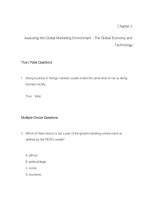Marketing chapter 7a understanding and reaching global consumers and market
Bạn đang xem bản rút gọn của tài liệu. Xem và tải ngay bản đầy đủ của tài liệu tại đây (3.12 MB, 100 trang )
McGraw-Hill/Irwin
Copyright © 2009 by The McGraw-Hill Companies, Inc. All Rights Reserved.
LEARNING OBJECTIVES (LO)
AFTER READING CHAPTER 7, YOU SHOULD BE ABLE TO:
LO1
Describe the nature and scope of world trade from a global
perspective and its implications for the United States.
LO2
Identify the major trends that have influenced the landscape of
global marketing in the past decade.
Identify the environmental factors that shape global marketing
LO3
efforts.
7-2
LEARNING OBJECTIVES (LO)
AFTER READING CHAPTER 7, YOU SHOULD BE ABLE TO:
LO4
Name and describe the alternative approaches companies use to
enter global markets.
LO5
Explain the distinction between standardization and customization
when companies craft worldwide marketing programs.
7-3
MATTEL’S GLOBAL MARKETING IS MORE THAN CHILD’S PLAY
Slide 7-5
DYNAMICS OF WORLD TRADE
LO1
WORLD TRADE FLOWS
Global Perspective
•
Countertrade
•
Trade Feedback Effect
United States Perspective
•
Gross Domestic Product (GDP)
•
Balance of Trade
7-5
DYNAMICS OF WORLD TRADE
•
World Trade Flows
– Dollar value of world trade has more than doubled in past decade and
will exceed $12.5 trillion in 2009
– Manufactured gods and commodities account for 75 percent of world
trade
– Service industries represent the other 25 percent
Slide 7-6
DYNAMICS OF WORLD TRADE
•
World Trade Flows
– Reflects interdependencies among industries, countries, and regions
– Manifests in country, industry, and regional exports and imports
Slide 7-6
DYNAMICS OF WORLD TRADE
•
Global Perspective
– U.S., Europe, Canada, China, and Japan account for more than twothirds of world trade
– Approximately 15 – 20 percent of world trade involves countertrade
– A country’s imports affect its exports, and vise versa – trade
feedback effect
Slide 7-6
DYNAMICS OF WORLD TRADE
•
United States Perspective
– Gross domestic Product (GDP)
– Balance of Trade
–
Exports vs. Imports
– Three largest importers of U.S. goods and services are Canada,
Mexico, and Japan
– The four largest exporters to U.S. are Canada, China, Mexico, and
Japan
Slide 7-6
FIGURE 7-1 World trade flows for goods and commodities within and
between geographic regions ($ billions U.S.)
7-10
DYNAMICS OF WORLD TRADE
LO1
COMPETITIVE ADVANTAGE OF NATIONS
Porter’s “Diamond”
•
Factor Conditions
•
Demand Conditions
•
Related and Supporting Industries
•
Company Strategy, Structure, and Rivalry
Economic Espionage Act (1996)
7-11
DYNAMICS OF WORLD TRADE
•
Competitive Advantage of Nations – Porter’s “Diamond”
–
Factor Conditions
•
Reflect a nation’s ability to turn its natural resources, education, and
infrastructure into a competitive advantage
–
Demand conditions
•
Include both the number and sophistication of domestic customers for
an industry’s product
Slide 7-6
DYNAMICS OF WORLD TRADE
•
Competitive Advantage of Nations – Porter’s “Diamond”
–
Related and Supporting Industries
•
Firms and industries seeking leadership in global markets need
clusters of world-class suppliers that accelerate innovation
–
Company Strategy, Structure, and Rivalry
•
Factors include conditions governing the way a nation’s businesses
are organized and managed, along with the intensity of domestic
competition
Slide 7-6
FIGURE 7-2 Porter’s diamond of national competitive advantage: 4 key
elements on why some countries become world leaders
7-14
DYNAMICS OF WORLD TRADE
•
Competitive Advantage of Nations – “The Dark Side”
–
Economic Espionage
•
Clandestine collection of trade secrets or proprietary information
about competitors
–
Economic Espionage Act (1996)
•
Theft of trade secrets by foreign entities a federal crime in the U.S.
Slide 7-6
Concept Check
1. What is the trade feedback effect?
A: The phenomenon in which a country’s imports affect its
exports and vice versa.
Slide 7-11
Concept Check
2. What variables influence why
some companies and industries
in a country succeed globally
while others lose ground or fail?
A: (1) factor conditions; (2) demand conditions; (3) related and
supporting industries; and (4) company strategy, structure, and
rivalry.
Slide 7-12
MARKETING IN A BORDERLESS ECONOMIC WORLD
•
Decline of Economic Protectionism
(Trends)
1.
2.
3.
4.
Gradual decline of economic protectionism by individual countries
Formal economic integration and free trade among nations
Global competition among global companies for global customers
Development of networked global marketplace
Slide 7-13
MARKETING IN A BORDERLESS
ECONOMIC WORLD
TREND 1—DECLINE OF ECONOMIC PROTECTIONISM
•
Decline of Economic Protectionism
–
Practice of shielding one or more industries within a country’s economy
from foreign competition, usually through tariffs and quotas
Slide 7-13
MARKETING IN A BORDERLESS
LO3
ECONOMIC WORLD
TREND 1—DECLINE OF ECONOMIC PROTECTIONISM
Protectionism
Tariffs
Quotas
General Agreement on
Tariffs and Trade (GATT)
World Trade Organization (WTO)
7-20
FIGURE 7-3 Protectionism hinders world trade through tariffs and quotas
policies of countries, raising prices and limiting supply
7-21
MARKETING IN A BORDERLESS
LO3
ECONOMIC WORLD
TREND 2—RISE OF ECONOMIC INTEGRATION
European Union
•
Euro
North American Free Trade Agreement (NAFTA)
Asian Free Trade Agreements
7-22
Euro Launch TV Ad
What are the benefits of economic integration?
QuickTime™ and a
YUV420 codec decompressor
are needed to see this picture.
7-23
FIGURE 7-4 The European Union in 2007 consists of 27 countries with more
than
500 million consumers
7-24
MARKETING IN A BORDERLESS
LO3
ECONOMIC WORLD
TREND 3—GLOBAL COMPETITION
•
A New Reality: Global Competition among Global Companies for
Global Consumers
Global Competition
•
Divisions or Subsidiaries
Strategic Alliances
7-25









